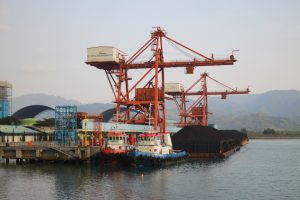Pacific Money | Economy
After pledging to stop funding coal-powered power plants last year, the ADB is developing a framework to speed up the region’s green transition.

A coal-fired power station near Batu Bintang, West Java, Indonesia.
Credit: Depositphotos
In 2021, the Asian Development Bank (ADB) announced it would no longer finance coal-fired power plants. This announcement was made at a time when other big players, like Japan and South Korea, were making similar commitments. If followed through on, such a change in policy would be a big deal given how much coal is burned in Southeast Asia every year.
In 2021, Indonesia consumed 112 million metric tons of coal for domestic electricity generation, more than double the 53 million tons it used in 2012. Even in Thailand, where natural gas dominates the energy mix, 22 million tons of coal were consumed for electricity in 2019.
In recent years, a lot of this coal-fired capacity has been financed by development banks in Japan, China, and South Korea, as well as the ADB. So a commitment to stop underwriting such projects will be very important. But now the ADB is going a step further, developing a framework that will not just cut off financing for coal but is intended to speed up the early retirement of coal-fired power plants and accelerate the transition to low carbon footprints around the region.
The framework is called the Energy Transition Mechanism (ETM) and it is early days; the details are still being worked out. But the basic goal is pretty straightforward: getting countries in Southeast Asia to retire coal-fired power plants before they reach the end of their useful economic life. Right now the plan is to roll it out in a few countries – Indonesia and the Philippines have already committed – and then scale it up.
The ETM involves developing financing mechanisms that are tailored to political-economic conditions in specific countries. If done well, this will address one of the major weaknesses of other policy tools like green finance, carbon taxes, or feed-in tariffs. These are broad-based policy instruments that are supposed to have wide applicability.
But when it comes to the production and distribution of energy every country is different. Some have more fossil fuel resources than others; some have deeper financial markets; some have more or less political support for green energy; some have vertically integrated state-owned monopolies while others have unbundled and privatized. With so much variation across countries, something like a carbon tax is going to impact energy policy very differently in Singapore than it is in Indonesia, for example.
At this point, we only have limited details on how the ETM will approach this puzzle, but the basic idea seems to be to approach each country on its own merits. For instance, in the Philippines, where almost all electricity generation comes from private companies (known as Independent Power Producers or IPPs), the ETM will likely seek to deal directly with these private companies and appeal to their commercial interests. One such plan could involve refinancing existing debt so that shareholders can be paid back faster from operating profits, which will in turn incentivize them to shutter the plants earlier than they otherwise would have.
The structure of energy production and distribution in Indonesia, on the other hand, is very different and so requires a different approach. Targeting Indonesian coal-fired IPPs with refinancing offers will make a much smaller dent in coal consumption than it will in the Philippines, since privatization is more limited. Instead, any clean energy transition in Indonesia requires the buy-in of state-owned utility PLN, which plays the most significant role in Indonesia’s electricity sector and doesn’t operate according to the same commercial logic as a private company.
PLN doesn’t need to return a cash dividend to its shareholder (the government of Indonesia) in the same way that private power companies in the Philippines do. But they are always on the lookout for more funding to build and operate more power plants. It would appear that the ETM has taken this into account, with PLN apparently on-board with the plan in principle. Presumably, the next step will be to start identifying and shutting down coal-fired plants that PLN owns and operates in exchange for concessional financing from the ETM earmarked for renewable energy projects.
It is early in this process, and the policy tools that will be rolled out are still being developed. But the overarching logic of adapting the plans to the existing political economy of each respective country is solid. In the Philippines, where energy production is structured around pro-market principles, the ETM will look to change the incentive structure for private companies. In Indonesia, where energy is more insulated from market pressures, the ETM will deal directly with PLN. In my opinion, the flexibility of this country-specific approach and the soundness of the underlying logic is what will give the ETM a good shot at achieving its goal of accelerating a transition to cleaner energy in the region.


